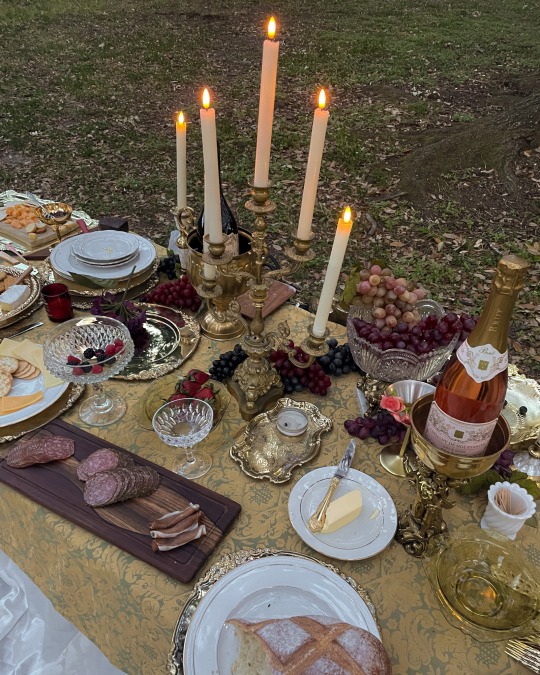#Greek antiquity
Explore tagged Tumblr posts
Text
Author & Timestamp: Margaret Talbot October 22, 2018 (almost 6 years old as of May 2, 2024)
Polychromy refers to "decoration in many colours, esp in architecture or sculpture". - Collins Dictionary. Extract of a much longer article (please note: I have shortened some sentences where possible and broken up some paragraphs by added spacing. I did this to try to make it a little easier for other neurodivergent people to read):

Researchers demonstrate the process of applying color to the Treu Head, from a Roman sculpture of a goddess, made in the second century A.D. Ancient sculptures were often painted with vibrant hair colors and skin tones. - Photograph by Mark Peckmezian for The New Yorker
For Abbe, [...] a professor of ancient art at the University of Georgia, the idea that the ancients disdained bright color “is the most common misconception about Western aesthetics in the history of Western art.” It is, he said, “a lie we all hold dear.”
[...]
[...] Marco Leona, who runs the scientific-research department at the Metropolitan Museum of Art [...] said, of polychromy, “It’s like the best-kept secret that’s not even a secret.”
Jan Stubbe Østergaard, a former curator at the Ny Carlsberg Glyptotek museum, in Copenhagen, and the founder of an international research network on polychromy, told me, “Saying you’ve seen these sculptures when you’ve seen only the white marble is comparable to somebody coming from the beach and saying they’ve seen a whale because there was a skeleton on the beach.”
[...]
[...] debate about ancient sculpture has taken on an unexpected moral and political urgency. [In 2017], a University of Iowa classics professor, Sarah Bond, published two essays [...] arguing that it was time we all accepted that ancient sculpture was not pure white—and neither were the people of the ancient world. One false notion, she said, had reinforced the other.
For classical scholars, it is a given that the Roman Empire—which, at its height, stretched from North Africa to Scotland—was ethnically diverse. In the Forbes essay, Bond notes, “Although Romans generally differentiated people on their cultural and ethnic background rather than the color of their skin, ancient sources do occasionally mention skin tone and artists tried to convey the color of their flesh.”
Depictions of darker skin can be seen on ancient vases, in small terra-cotta figures, and in the Fayum portraits, a remarkable trove of naturalistic paintings from the imperial Roman province of Egypt, which are among the few paintings on wood that survive from that period. These near-life-size portraits, which were painted on funerary objects, present their subjects with an array of skin tones, from olive green to deep brown, testifying to a complex intermingling of Greek, Roman, and local Egyptian populations. (The Fayum portraits have been widely dispersed among museums.)
Bond [had] been moved to write her essays when a racist group, Identity Evropa, started putting up posters on college campuses, including Iowa’s, that presented classical white marble statues as emblems of white nationalism. After the publication of her essays, she received a stream of hate messages online. She is not the only classicist who has been targeted by the so-called alt-right. Some white supremacists have been drawn to classical studies out of a desire to affirm what they imagine to be an unblemished lineage of white Western culture extending back to ancient Greece. When they are told that their understanding of classical history is flawed, they often get testy.
[In early 2018], the BBC and Netflix broadcast “Troy: Fall of a City,” a miniseries in which the Homeric hero Achilles is played by a British actor of Ghanaian descent. The casting decision elicited a backlash in right-wing publications. Online commenters insisted that the “real” Achilles was blond-haired and blue-eyed, and that someone with skin as dark as the actor’s surely would have been a slave.
It’s true that Homer describes the hair of Achilles as xanthos, a word often used to characterize objects that we would call yellow, but Achilles is [mythological], so imaginative license in casting seems perfectly acceptable. Moreover, several scholars explained online that, though ancient Greeks and Romans certainly noticed skin color, they did not practice systematic racism. They owned slaves, but this population was drawn from a wide range of conquered peoples, including Gauls and Germans.
Nor did the Greeks conceive of race the way we do. [...] Rebecca Futo Kennedy, a classicist at Denison University, who writes on race and ethnicity, told me, “Cold weather made you stupid but also courageous, so that was what people from the Far North were supposed to be like. And the people they called Ethiopians were thought of as very smart but cowardly. It comes out of the medical tradition [of the Hippocratic humours]. In the North, you have plenty of thick blood. Whereas, in the South, you’re being desiccated by the sun, and you have to think about how to conserve your blood.”
Pale skin on a woman was considered a sign of beauty and refinement, because it showed that she was privileged enough not to have to work outdoors. But a man with pale skin was considered unmasculine: bronzed skin was associated with the heroes who fought on battlefields and competed as athletes, naked, in amphitheatres.
[...] Tim Whitmarsh, a professor of Greek culture at the University of Cambridge, writes that the Greeks “would have been staggered” by the suggestion that they were “white.” Not only do our modern notions of race clash with the thinking of the ancient past; so do our terms for colors, as is clear to anyone who has tried to conceive what a “wine-dark sea” actually looked like.
[...]
On the website Pharos, which was founded [...] in part to counter white-supremacist interpretations of the ancient world, a recent essay notes, “Although there is a persistent, racist preference for lighter skin over darker skin in the contemporary world, the ancient Greeks considered darker skin” for men to be “more beautiful and a sign of physical and moral superiority.”
[In 2017], high-school students participating in a summer program at the RISD Museum, in Providence, were so fascinated to learn about polychromy in classical statuary that they made a coloring book allowing gallery visitors to create brightly hued versions of the objects on display.
Christina Alderman, who runs the program, told me, “The moment they found out that the statues were originally painted, I just lost them to that idea. They were, like, ‘Wait, are you serious? I’ve played video games set in ancient times, and all I see are white sculptures. I watch movies and that’s all I see.’ It was a real human response—they kind of felt they’d been lied to.”

A marble head of a deity wearing a Dionysiac fillet, from the first century A.D. Traces of red pigment remain on the lips, eyes, and fillet. Marco Leona, who runs the scientific-research department at the Metropolitan Museum of Art, said the fact that ancient statues were once painted is “like the best-kept secret that’s not even a secret.” - Courtesy Metropolitan Museum of Art

A bust of a young African boy, sculpted in the first century B.C. Ancient sculptures of African people were often made of basalt and painted with reddish-brown layers to create a lifelike effect. Mahogany-colored paint is still visible on the boy’s face. - Courtesy Museum für Kunst und Gewerbe Hamburg
/endofextract
[I edited this blog post to provide a definition of polychromy and fix a couple of typos. - May 3, 2024]
#classical studies#history#ancient#ancient history#antiquity#classical antiquity#The New Yorker#polychromy#museum politics#museum problems#classical history#classical rome#classical greece#ancient greece#ancient greek#archaic greece#greek antiquity#greek sculpture#Greek and Roman sculpture#ancient sculpture#white supremacy#older article#article#art history#art galleries#muesums#racism#european history
4 notes
·
View notes
Text

Pot Face (2024), digital drawing
#art#wacom#wacom tablet#digital drawing#illustration#drawing#digital art#flower pot#urn#greek antiquity#sarah van sloten#amphora
3 notes
·
View notes
Text

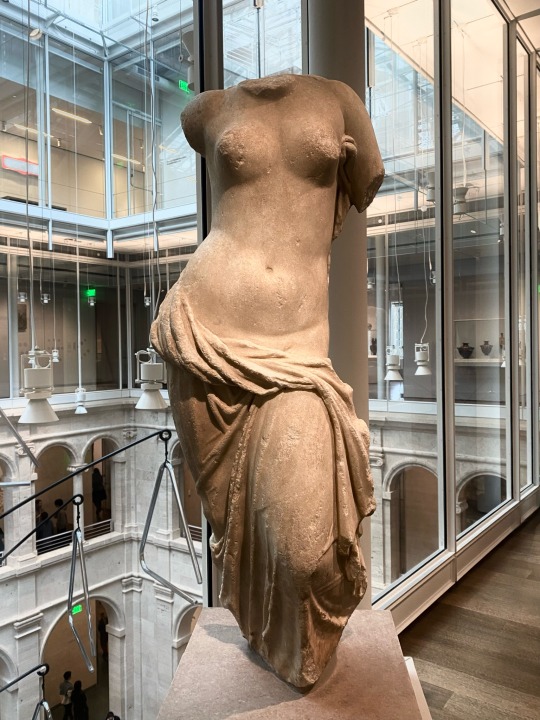
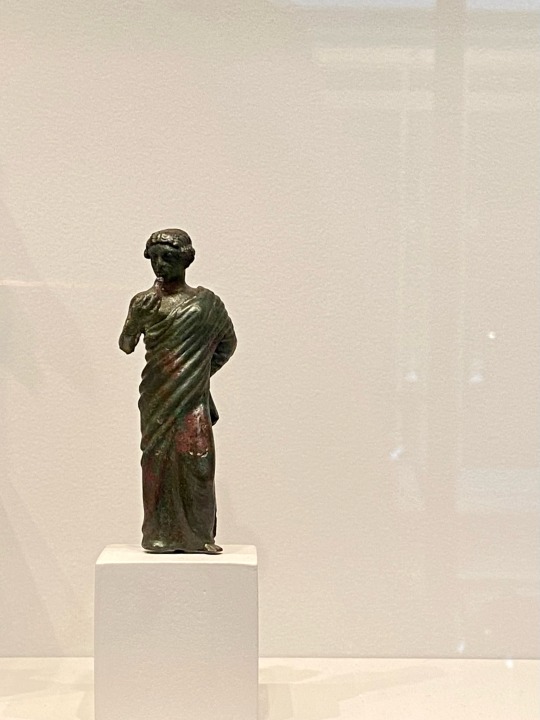



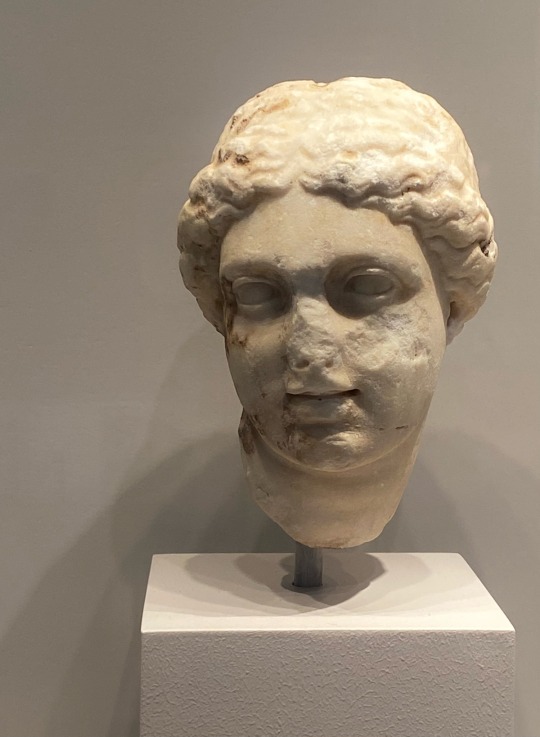


building my mood board at the harvard art museum
#art history#aphrodite#greek history#greek mythology#antique#salome#sculpture#classic mythology#moodboard#antiquity#Greek antiquity#aesthetic#inspo
7 notes
·
View notes
Text

A bracelet clasp with a Medusa on an emerald cameo. Gold is treated with diamond and enamel. 18th century. Made in England.
#medusa#snakes#clasp#enamel jewelry#enamel#gold#green#emerald#cameo#antique jewelry#vintage jewelry#antiquities#ancient jewelry#greek mythology#jewelry#toya's tales#style#toyastales#toyas tales#fashion#art#clothing#summer#september#accessories#fashion accessories#fashion photography#fashion inspiration#fashion history#art history
16K notes
·
View notes
Text

Eastern greek fluorite carved idol: Owl.
4th - 3rd century BC.
Private Collection.
#found#art#sculpture#ancient art#antiquities#classical antiquity#owl#owl art#Greek#ancient greece#ancient greek#fluorite#pre christian art
2K notes
·
View notes
Text

The Triumph of Light over Darkness by Franz von Matsch
#franz von matsch#art#light#darkness#supernatural#pagan#paganism#religious art#religion#gods#goddess#goddesses#torch#horse#wings#europe#european#classical antiquity#ancient greek#greek mythology#roman mythology#ancient rome#classical#classicism#sun#clouds#mythical creatures#winged horse#day#night
2K notes
·
View notes
Text

In an Irish House, 1988
#vintage#interior design#home#vintage interior#architecture#home decor#style#1980s#Greek#key#floral#wallpaper#antique#porcelain#shells#portrait#daylily#console table#classical#country#Ireland
1K notes
·
View notes
Text

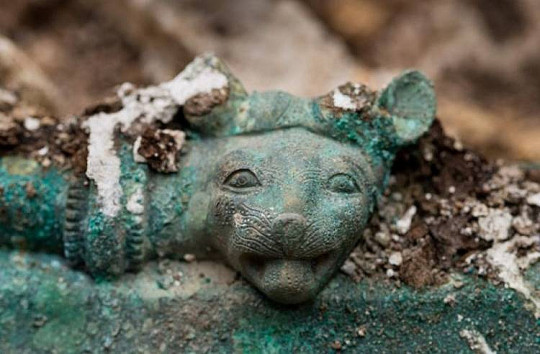
Details of an enormous bronze cauldron discovered a few years ago by French archaeologists near the town of Lavau in a tomb of a Celtic nobleman. The burial dates to around 500 BC and the cauldron itself is of Etruscan or Greek manufacture, showcasing the extensive trade links during the period.
#ancient history#ancient art#lavau grave#grave goods#bronze#bronze cauldron#hallstatt#greek#etruscan#antiquities#ancient civilisations#artifact#archaeology
576 notes
·
View notes
Text





The Derveni Krater, a masterpiece of ancient metalwork. Found in Derveni, near Thessaloniki, in 1965. The funerary inscription on the krater writes it's dedicated to Astiouneios, son of Anaxagoras, from Larissa, an aristocrat. Some believe that this elaborate artefact was made in Athens while others suppose that it could be created in the Macedonian court, the date of its creation isn't clear as well, generally categorised as Hellenistic. What is most important though is the krater's vivid, playful and sensual decoration with satyrs, maenads and the pair of Dionysus and Ariadne. Usually, when someone died unmarried and the family had the means, such a depiction of a happy mated afterlife was preferred so to comfort the relatives for their loss. The relationship depicted between Dionysus and Ariadne seems more than sensual, the transparency of her clothing, along with his nakedness and their stances are more than revealing of their common passion.
Now at the Archaeological Museum of Thessaloniki, Greece. The Derveni Krater may seem gold but it's actually made of bronze.
#mythology#art#symbolism#ancient greece#greek gods#ancient art#dionysus#ariadne#greek museums#antiquity#derveni krater#masterpiece#hieros gamos#satyrs#maenads#sensuality#ancient greek religion
623 notes
·
View notes
Text
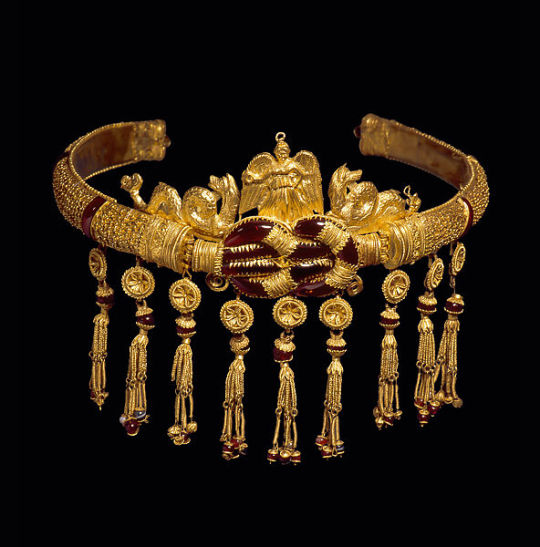
Greek Gold diadem with Hercules knot (250–150 BCE),
Gold, garnet, carnelian, sardonyx
3×9 1/8 in. (7.6 × 23.1 cm).
On loan to the Metropolitan Museum.
#greek art#ancient artifacts#ancient art#antiquities#antiquity#jewellery#archeology#met museum#art history#history#garnet#carnelian#sardonyx#heracles#hercules
3K notes
·
View notes
Text

Excerpt: "Like all lyric poets of her time, Sappho was steeped in the affects and story world of Homeric epic, the language, characters, and themes of her lyrics often intersecting with those of Homer. Yet the relationship between these two poets has usually been framed as competitive and antagonistic. Mueller’s book charts a more promising way forward, setting Sappho and Homer side by side within the embrace of a non-hierarchical, “reparative reading” culture, as first conceived by queer theorist and poet Eve Kosofsky Sedgwick."
#to read list#Melissa Mueller#classics#archaic Greece#Sappho#Cambridge University Press#Sappho and Homer: A Reparative Reading#reparative reading#lyric poetry#epic poetry#ancient Greece#Homer#homeric#homeric epic#queer theory#Greek antiquity#antiquity#ancient#gender#sexuality#classical studies
0 notes
Text

apollo driving his chariot
honestly i made this one month ago but onpy posted it on my old tiktok. gave up on drawing the other horses sorry
#ancient history#greek mythology#greek gods#ancient greece#apollo#greek myth#hellenism#antiquity#digital art#epic the musical
450 notes
·
View notes
Text
Ancient Necklace with Mosaic Glass Beads, from the Eastern Mediterranean, c.100 BCE-100 CE: this necklace is composed of 30 glass beads, most of which are decorated with stylized faces

From the John Paul Getty Museum:
The beads are made of multi-colored opaque glass and are decorated with heads and floral designs. The necklace is in good condition; some beads are chipped or cracked.

The exact origin of this piece is unknown, but it can be traced back to the Eastern Mediterranean, where it was likely made by a Greek or Roman artist.
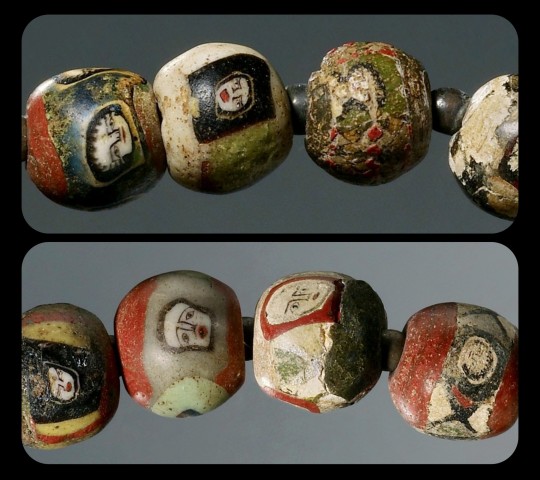
Each bead has a width of about 1.2cm (roughly half an inch); they're decorated with remarkably intricate details, and each face is depicted in its own unique style.

Sources & More Info:
John Paul Getty Museum: Necklace with Mosaic Glass Beads
#archaeology#artifact#history#ancient history#art#greek#roman#ancient art#antiquity#jewelry#beading#glass art#mosaic#crafting#greek art#roman art#eastern mediterranean#ancient#necklace#fashion#style#classical archaeology
2K notes
·
View notes
Text

Columns | Athens
#athens#greece#architecture#ancient architecture#ancient ruins#ruins#travel#column#columns#original photographers#photographers on tumblr#ancient greece#greek#art#history#antiquity#classical#temples#europe#archaelogy
800 notes
·
View notes
Text


child's toy horse from Greek tomb (two views) - ceramic - Kerameikos Archaeological Museum, Athens - 950-900 BCE
266 notes
·
View notes
